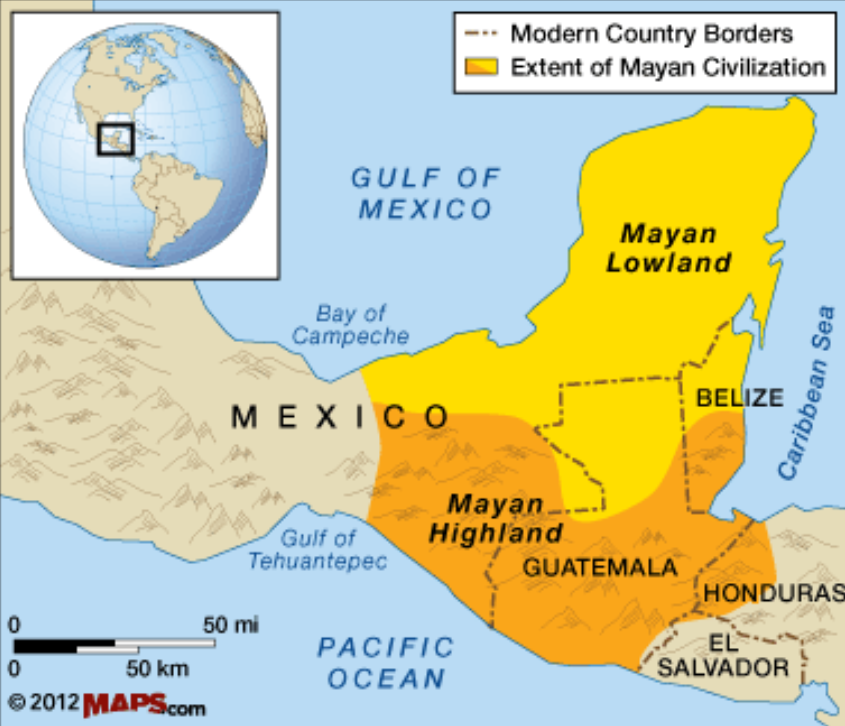What happened?
- The Maya Classic Period (c. 250–900 CE) was the “golden age” of the Maya Empire in Central or Meso-America (see map below).
- Agriculture flourished, resulting in the civilization reaching its peak population of up to 2 million people during this time. Cities grew in size and number, with the most springing up between 440 and 660 CE. Although this time period was overall very productive for the Maya, there was a 100-year “dark age” beginning c. 540 CE in which productivity decreased significantly.
- During the 8th and 9th centuries, cities in the southern lowlands were gradually abandoned one by one. By 900 CE, this region of the empire was almost completely abandoned and the Classic Period was brought to a close.

Map of Central America (from National Geographic Society, “Geography in the News: Demise of the Maya” 2012).
How is this related to climate?
- Abnormally wet weather contributed to the rise of the Maya Classic Period. During the early Classic Period, the weather was wetter than it had been in the previous thousand years.
- Heavy precipitation allowed for successful agriculture and abundant crop yields, which supported growing populations.
- The wettest decades, which were between 440 and 660 CE, coincided with the establishment of large numbers of new cities.
- There are many possible causes of the collapse of the Maya Classic Period, including warfare, environmental degradation, drought and shifting trade routes.
- Perhaps the most influential were a series of droughts, each lasting between 3 and 20 years and decreasing annual precipitation by a range of 41% to 54%.
- Droughts led to crop failure, which in turn may have led to increased tensions and warfare between city-states.
- Intense deforestation likely exacerbated the natural droughts. Cleared land absorbs less solar radiation as opposed to forested land. This results in less water evaporating from the surface, reducing clouds and precipitation. Deforestation may have contributed to the decrease in precipitation by 5% to 15%. .
Further Exploration
- Although Maya society had collapsed in the southern lowlands by 900 CE, cities in the northern lowlands (present-day Yucatan Peninsula) rose to prominence. New cities were also established in the highlands (present-day Guatemala). The civilization continued to exist in the region until the Spanish Conquest around 1540 CE.
- The Maya cleared large areas of land for agriculture, as well as for making lime plaster for temples and monuments. 20 trees had to be burned to heat enough limestone to make 1 square meter of lime plaster.
References and additional resources
- Coulter, D. “The Fall of the Maya: ‘They Did It to Themselves’.” NASA. 2009. https://science.nasa.gov/science-news/science-at-nasa/2009/06oct_maya/.
- Gabriele, M. “How Massive Drought Ended The Classic Mayan Civilization (And Why We Already Knew That).” Forbes. 2018, www.forbes.com/sites/matthewgabriele/2018/08/10/drought-mayan-civilization-we-already-knew-that/.
- Herrero, H. “Changing Climate and the Maya.” National Geographic Society. 2012. www.nationalgeographic.org/media/changing-climate-and-maya/.
- History.com Editors. “Maya.” History. 2009. www.history.com/topics/ancient-americas/maya.
- Mott, N. “Why the Maya Fell: Climate Change, Conflict-And a Trip to the Beach?” National Geographic. 2012. www.nationalgeographic.com/news/2012/11/121109-maya-civilization-climate-change-belize-science/.
- Nix, E. “This Is Why the Maya Abandoned Their Cities.” History. 2016. www.history.com/news/why-did-the-maya-abandon-their-cities.
- Parry, W. “What Was Behind Mysterious Collapse of the Mayan Empire?” LiveScience. 2012. www.livescience.com/22581-mayan-empire-collapse-explained.html.
- Stromberg, J. “Why Did the Mayan Civilization Collapse? A New Study Points to Deforestation and Climate Change.” Smithsonian. 2012. www.smithsonianmag.com/science-nature/why-did-the-mayan-civilization-collapse-a-new-study-points-to-deforestation-and-climate-change-30863026/.
- Supriya, L. “Severe Cyclones May Have Played a Role in the Maya Collapse.” Eos. 2020. www.eos.org/articles/severe-cyclones-may-have-played-a-role-in-the-maya-collapse.
